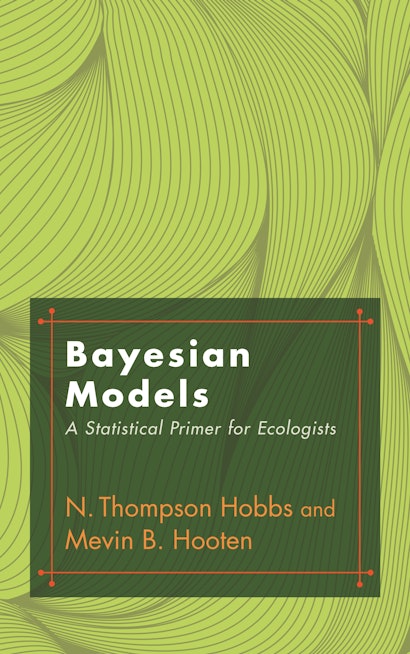Bayesian modeling has become an indispensable tool for ecological research because it is uniquely suited to deal with complexity in a statistically coherent way. This textbook provides a comprehensive and accessible introduction to the latest Bayesian methods—in language ecologists can understand. Unlike other books on the subject, this one emphasizes the principles behind the computations, giving ecologists a big-picture understanding of how to implement this powerful statistical approach.
Bayesian Models is an essential primer for non-statisticians. It begins with a definition of probability and develops a step-by-step sequence of connected ideas, including basic distribution theory, network diagrams, hierarchical models, Markov chain Monte Carlo, and inference from single and multiple models. This unique book places less emphasis on computer coding, favoring instead a concise presentation of the mathematical statistics needed to understand how and why Bayesian analysis works. It also explains how to write out properly formulated hierarchical Bayesian models and use them in computing, research papers, and proposals.
This primer enables ecologists to understand the statistical principles behind Bayesian modeling and apply them to research, teaching, policy, and management.
- Presents the mathematical and statistical foundations of Bayesian modeling in language accessible to non-statisticians
- Covers basic distribution theory, network diagrams, hierarchical models, Markov chain Monte Carlo, and more
- Deemphasizes computer coding in favor of basic principles
- Explains how to write out properly factored statistical expressions representing Bayesian models
N. Thompson Hobbs is senior research scientist at the Natural Resource Ecology Laboratory and professor in the Department of Ecosystem Science and Sustainability at Colorado State University. Mevin B. Hooten is associate professor in the Department of Fish, Wildlife, and Conservation Biology and the Department of Statistics at Colorado State University, and assistant unit leader in the US Geological Survey's Colorado Cooperative Fish and Wildlife Research Unit.
"A refreshing and solid read for anyone confused or distracted by Bayesian recipe books."—Carsten F. Dormann, Quarterly Review of Biology
"This pitch-perfect exposition shows how Bayesian modeling can be used to quantify our uncertain world. Ecologists—and for that matter, scientists everywhere—are aware of these uncertainties, and this book gives them the understanding to do something about it. Hobbs and Hooten take us on a signposted journey through the culture, construction, and consequences of conditional-probability modeling, readying us to take our own scientific journeys through uncertain landscapes."—Noel Cressie, University of Wollongong, Australia
"Hobbs and Hooten provide a complete guide to Bayesian thinking and statistics. This is a book by ecologists for ecologists. One of the powers of Bayesian thinking is how it enables you to evaluate knowledge accumulated through multiple experiments and publications, and this excellent primer provides a firm grounding in the hierarchical models that are now the standard approach to evaluating disparate data sets."—Ray Hilborn, University of Washington
"In this uniquely well-written and accessible text, Hobbs and Hooten show how to think clearly in a Bayesian framework about data, models, and linking data with models. They provide the necessary tools to develop, implement, and analyze a wide range of ecologically interesting models. There's something new and exciting in this book for every practicing ecologist."—Aaron M. Ellison, Harvard University
"Hobbs and Hooten provide an important bridge between standard statistical texts and more advanced Bayesian books, even those aimed at ecologists. Ecological models are complex. Building from likelihood to simple and hierarchical Bayesian models, the authors do a superb job of focusing on concepts, from philosophy to the necessary mathematical and statistical tools. This practical and understandable book belongs on the shelves of all scientists and statisticians interested in ecology."—Jay M. Ver Hoef, Statistician, NOAA-NMFS Alaska Fisheries Science Center
"Tackling an important and challenging topic, Hobbs and Hooten provide non-statistically-trained ecologists with the skills they need to use hierarchical Bayesian models accurately and comfortably. The combination of technical explanations and practical examples is great. This book is a valuable contribution that will be widely used."—Benjamin Bolker, McMaster University
"This excellent book is one of the best-written and most complete primers on Bayesian hierarchical modeling I have seen. Hobbs and Hooten anticipate many of the common pitfalls and concerns that arise when non-statisticians are introduced to this material. Researchers across a wide range of disciplines will find this book valuable."—Christopher Wikle, University of Missouri


